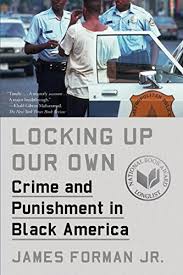The Road to Mass Incarceration
Why does America imprison so many people? And why are those who lives are all tangled up in our criminal justice system so often people of color? It is a question that drove James Forman, Jr., to write an extraordinarily powerful and important book, Locking Up Our Own: Crime and Punishment in Black America. The book has received a great deal of well-deserved attention. Forman, a professor of law at Yale, makes it clear that this issue is central to understanding crime and justice in the US.

Forman, a former public defender, opens the narrative recounting the sentencing of a young black man in a Washington, D.C., all-black courtroom. He is angered, frustrated, upset, and wonders: “How did a majority-black jurisdiction end up incarcerating so many of its own?” The book is a well-researched attempt to answer that question, looking at politics, economics, and social history. Forman readily acknowledges the role of whites to promote mass incarceration, but his focus here is on black leadership and black communities. Doing so, he highlights extremely important issues of class. In 2000, “the lifetime risk of incarceration for black high school dropouts was ten times higher than it was for African Americans who attended college.”
The book is organized into two parts: origins and consequences. Forman’s personal experience as an attorney, a public defender, and community member buttresses his research throughout. He starts with the 1970s and the debate over marijuana laws and their enforcement. Within the Washington, DC community, David Clark, an African-American lawyer, successfully ran for city council with an aim to end prison as a potential penalty for marijuana possession. Then, as now, a drug possession conviction could have negative consequences for someone’s entire life.
Moderate as Clarke’s proposal was, it struggled to gain acceptance. Many political leaders in the black community worried about heroin and believed that any weakening of anti-drug laws would cause further problems. The bill died, foundering on the shores of moral hazard.
At the same time, a growing crime epidemic in DC within the black community outraged law-abiding citizens. With increasing calls for “getting tough on crime,” gun control legislation passed in the District. Dissenters unsuccessfully argued that it would weaken the right to defend one’s self. The result were stiffer penalties for gun possession without systemic efforts to address the causes of crime.
Forman’s chapter on the integration of color into the police is worthy of lengthy analysis on its own. He notes that “the case for black police has always been premised on the unquestioned assumption of racial solidarity between black citizens and black officers.” As it turns out, that assumption was and remains incorrect.
Consequences picks up with changes in sentencing in the 1980s. Forman explains how many in the black community in DC were let down by police and the courts – and how that frustration led to calls for longer and harsher sentences. Drug dealers were excoriated by black leaders. Mandatory sentencing was championed by many who distrusted the system. In 1982, Initiative 9 was overwhelming passed in an District-wide election. It called for a minimum mandatory sentence of five years for committing a violent felony with a gun for the first offense and ten years for all further offenses. Selling heroin netted a four-year minimum sentence, with two years for cocaine and one year for large amounts of marijuana. And again, not much was done to address underlying causes or treatment.
A serious problem that became a media frenzy, the epidemic of crack cocaine in the late 1980s and early 1990s led to greater gang violence and even more dramatic responses. Political leaders – often African American – hyped anti-crime measures and and increased policing presence. Forman rightly calls this the rise of “warrior policing.” In addition to more police sweeps, more violence, assets were seized. The toll on the black community was devastating, both from crack and the response to it.
The book concludes with implementation of “stop and frisk” and an epilogue that summarizes how we got to mass incarceration: “the result of a series of small decisions, made over time, by a disparate group of actors.” It is rare to see so many efforts over so long to address problems with policy choices that have not done what many have hoped. Forman argues that if we are to do something about these issues and the resulting institutional race and class problems, we will have to recognize the failures and start with small steps. In other words, we have take it apart the same way it was built, with securing local political support and greater awareness. While this may not be optimistic conclusion, it is practical – and it makes sense.
This is a very good book.
David Potash